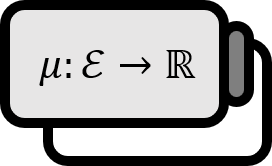Proof of the Karatheodory's Theorem
Definition1
For all $A \subset X$, if the following equation holds, then $E \subset X$ is said to satisfy the Caratheodory condition, or $E$ is said to be $\mu^{\ast}$-measurable.
$$ \begin{equation} \mu^{\ast}(A) = \mu^{\ast}(A\cap E) + \mu^{\ast}(A \cap E^{c}) \label{def1} \end{equation} $$
$\mu^{\ast}$ is an outer measure.
Theorem
Let $L$ be the set that includes all $E \subset X$ that satisfy the Caratheodory condition. Then, $L$ is a $\sigma$-algebra. Also, $\mu^{\ast}$ becomes a measure on $L$.
This is known as the Caratheodory theorem.
Explanation
If we say $X=\mathbb{R}^n$, then $L$ is called the Lebesgue $\sigma$-algebra of $\mathbb{R}^n$. And, $E$ is called the Lebesgue measurable set or simply measurable set of $\mathbb{R}^n$. And at this time, the outer measure $\mu^{\ast}$ is called the Lebesgue measure on $\mathbb{R}^n$.
Proof
To show that $\mu^{\ast}$ becomes a measure on $L$, it suffices to check if the following three conditions are met by definition.
(D1) $\mu^{\ast}(\varnothing)=0$
(D2) $\mu^{\ast} : L \to [0,\infty]$
(D3) For distinct $E_{i} \subset X$, $\mu^{\ast}\left(\bigsqcup \limits_{i=1}^{\infty} E_{i} \right) = \sum \limits_{i=1}^{\infty}\mu^{\ast}(E_{i}) $
However, this is trivially satisfied by the definition and properties of the outer measure.
To show that $L$ is a $\sigma$-algebra, it suffices to check if the following conditions are met by definition.
Let a set $X$ be given. The collection $\mathcal{E} \subset \mathcal{P}(X)$ of subsets of $X$ that satisfies the following conditions is called a $\sigma$-algebra.
- (D1) $\varnothing, X \in \mathcal{E}$
- (D2) $E \in \mathcal{E} \implies E^{c} \in \mathcal{E}$
- (D3) $E_{k} \in \mathcal{E}\ (\forall k \in \mathbb{N}) \implies \bigcup_{k=1}^\infty E_{k} \in \mathcal{E}$
(D1)
By substituting $E$ with $\varnothing$, and $X$, it’s easy to verify that it holds based on the Caratheodory condition.
(D2)
This trivially holds by the definition of the Caratheodory condition.
(D3)
Unlike the previous two conditions, this is not straightforward to verify. First, it will be shown that when $E_{1}$ and $E_{2}$ satisfy $\eqref{def1}$, then $E_{1} \cup E_{2}$ also satisfies $\eqref{def1}$.
Part 1.
Since $E_{1}$ satisfies $\eqref{def1}$ by assumption, the following holds:
$$ \mu^{\ast}(A)=\mu^{\ast}(A \cap E_{1}) + \mu^{\ast}(A \cap E_{1}^{c}) $$
Similarly, since $E_{2}$ also satisfies $\eqref{def1}$, the following holds:
$$ \begin{align*} \mu^{\ast}(A) &= \mu^{\ast}(A \cap E_{1}) + \mu^{\ast}(A \cap E_{1}^{c}) \\ &= \mu^{\ast} \big( (A \cap E_{1})\cap E_{2} \big) + \mu^{\ast} \big( (A \cap E_{1})\cap E_{2}^{c} \big) \\ &\quad + \mu^{\ast} \big( (A \cap E_{1}^{c})\cap E_2 \big)+\mu^{\ast} \big( (A \cap E_{1}^{c})\cap E_{2}^c \big) \end{align*} $$
By the countable subadditivity of the outer measure, the following equation holds:
$$ \mu^{\ast} \Big( \big[ A\cap E_{1}\cap E_{2} \big] \cup \big[ A \cap E_{1} \cap E_{2}^{c}\big] \cup \big[ A \cap E_{1}^{c} \cap E_2 \big] \Big) \\ \le \mu^{\ast} \big( A \cap E_{1}\cap E_2 \big) + \mu^{\ast} \big( A \cap E_{1}\cap E_{2}^{c} \big) + \mu^{\ast} \big( A \cap E_{1}^{c}\cap E_2 \big) $$
Thus, the following holds:
$$ \begin{align*} & \mu^{\ast}(A) \\ \ge& \mu^{\ast} \Big( \big[ A\cap E_{1}\cap E_{2} \big] \cup \big[ A \cap E_{1} \cap E_{2}^{c}\big] \cup \big[ A \cap E_{1}^{c} \cap E_2 \big] \Big) + \mu^{\ast} (A \cap E_{1}^{c} \cap E_{2}^c ) \\ =&\ \mu^{\ast} \big( A\cap \big[ (E_{1}\cap E_{2}) \cup (E_{1} \cap E_{2}^{c}) \cup ( E_{1}^{c} \cap E_{2}) \big] \Big) + \mu^{\ast} (A \cap E_{1}^{c} \cap E_{2}^c ) \\ =&\ \mu^{\ast} \big( A\cap (E_{1} \cup E_{2}) \big) + \mu^{\ast} (A \cap E_{1}^{c} \cap E_{2}^c ) \\ =&\ \mu^{\ast} \big( A\cap (E_{1} \cup E_{2}) \big) + \mu^{\ast} \big(A \cap (E_{1} \cup E_2 )^{c} \big) \end{align*} $$
Therefore, when $E_{1}$ and $E_{2}$ satisfy $\eqref{def1}$, $E_{1}\cup E_{2}$ also satisfies $\eqref{def1}$. By repeating this, it can be understood that any given $N$ distinct $E_{i}$s satisfying $\eqref{def1}$ implies that $\bigsqcup_{i=1}^{N} E_{i}$ also satisfies $\eqref{def1}$.
Part 2.
The initial condition lacks the distinctness of each $E_{i}$, which is necessary for the proof, so a bit of trickery is needed. First, define each $\tilde{E}_{i}$ as follows:
$$ \begin{align*} \tilde{E}_{1} &= E_{1} \\ \tilde{E}_{2} &= E_{2} \cap \tilde{E}_{1}^{c} \\ \tilde{E}_{3} &= E_{3} \cap (\tilde{E}_{1} \cup \tilde{E}_{2} )^{c} \\ \tilde{E}_{4} &= E_{4} \cap (\tilde{E}_{1} \cup \tilde{E}_{2} \cup \tilde{E}_{3})^{c} \\ &\vdots \end{align*} $$
Then, each of the $\tilde{E}_{i}$s are disjoint, satisfy $\eqref{def1}$, and the following holds:
$$ \bigsqcup_{i=1}^\infty \tilde{E}_{i} = \bigsqcup _{i=1}^\infty E_{i} $$
This can be easily verified by direct calculation. Therefore, it can now be shown without loss of generality that when each of the $\tilde{E}_{i}$s satisfies $\eqref{def1}$, $ \bigsqcup_{i=1}^\infty \tilde{E}_{i}$ also satisfies $\eqref{def1}$, completing the proof.
Part 3.
By the countable subadditivity, the following holds:
$$ \mu^{\ast} (A) \le \mu^{\ast}\left(A \cap \left( \bigsqcup _{i=1}^\infty \tilde{E}_{i}\right) \right) + \mu^{\ast} \left(A \cap \left( \bigsqcup _{i=1}^\infty \tilde{E}_{i} \right)^{c} \right) $$
Showing the opposite direction of inequality completes the proof. Since it was shown in Part 1. that it holds for $N$, the following holds:
$$ \begin{align*} \mu^{\ast} (A) &= \mu^{\ast} \left( A \cap \left( \bigsqcup _{i=1}^N \tilde{E}_{i}\right) \right) + \mu^{\ast} \left(A \cap \left( \bigsqcup _{i=1}^N \tilde{E}_{i} \right)^{c} \right) \\ &\ge \mu^{\ast} \left( A \cap \left( \bigsqcup _{i=1}^N \tilde{E}_{i}\right) \right) + \mu^{\ast} \left(A \cap \left( \bigsqcup _{i=1}^\infty \tilde{E}_{i} \right)^{c} \right) \\ &= \sum \limits_{i=1}^N\mu^{\ast}\left(A \cap \tilde{E}_{i} \right) + \mu^{\ast} \left(A \cap \left( \bigsqcup _{i=1}^\infty \tilde{E}_{i} \right)^{c} \right) \end{align*} $$
This inequality holds for all $N$, so the following equation holds:
$$ \begin{align*} \mu^{\ast} (A) & \ge \sum \limits_{i=1}^\infty \mu^{\ast}\left(A \cap \tilde{E}_{i} \right) + \mu^{\ast} \left(A \cap \left( \bigsqcup _{i=1}^\infty \tilde{E}_{i} \right)^{c} \right) \\ &\ge \mu^{\ast} \left( A \cap \left( \bigsqcup_{i=1}^\infty \tilde{E}_{i} \right) \right) + \mu^{\ast} \left(A \cap \left( \bigsqcup _{i=1}^\infty \tilde{E}_{i} \right)^{c} \right) \end{align*} $$
The second inequality holds by countable subadditivity.
■
Robert G. Bartle, The Elements of Integration and Lebesgue Measure (1995), p100 ↩︎
